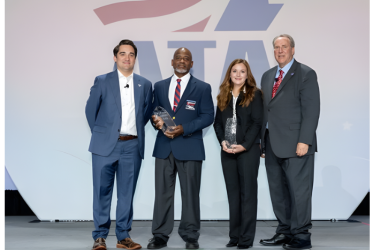President Dwight D. Eisenhower signed the Federal-Aid Highway Act of 1956 from a hospital bed at Walter Reed Army Medical Center in Maryland while recovering from a stint of an intestinal disease. This signing authorized the funding of the Interstate Highway System and changed the U.S. transportation industry, Freightwaves.com reported.
“No one could have envisioned the impact that vehicle traffic was going to have on our economy,” said Mark Spangler, curator of Lebanon, Missouri’s Route 66 Museum.
This authorization would eventually lead to 328.53 miles of I-44 across Oklahoma, 293.39 miles throughout Missouri, and 14.77 miles in Texas. Missouri was the first state to create highway construction contracts in August 1956.
“This stretch of I-44 just outside Lebanon was actually the first contract let under the Federal-Aid Highway Act of 1956,” Spangler said. “When we finished our stretch out here it had a Route 66 sign on it. It had not been assigned as Interstate 44 yet.”
Comparatively, construction began two years later in 1958 on Oklahoma’s corridors of I-44. The construction eventually led to I-44 existing as three Oklahoma toll roads: the H.E. Bailey Turnpike running north-south in southwestern Oklahoma; the Turner Turnpike on a northeast-southwest route; and the Will Rogers Turnpike which runs to the Missouri state line.
The historic 1956 construction in Missouri began the state’s critical role in connecting the United States and its transportation industry through interstate. TRIP, a national transportation research nonprofit has investigated Missouri’s influence on U.S. transportation.
“At 66-years-old, Missouri’s and the nation’s interstates are busier and working harder than ever,” said Carolyn Kelly, TRIP’s director of communications and research. “Missouri’s nearly 1,400 miles of interstate are the workhorse of the state’s transportation network. They carry 21.5 million vehicle-miles of travel each year. And since those shovels first hit the dirt in 1956 the number of vehicles in Missouri has increased more than 3.5 times and the state’s population has increased by more than two million residents.”
And despite the high level of traffic on Missouri’s interstates ($481 billion worth of goods are transported within state lines) they are in good condition. It’s reported that only 1% of the state’s interstate pavement is regarded in poor condition, 2% lower than the U.S. average.
Upkeep on I-44 extends beyond Missouri. Oklahoma took on its own project to widen the interstate in Tulsa during the early 2000s.
Missouri’s interstate system also ranks surprisingly low in on-road fatalities, with it carrying 27% of Missouri’s traffic while only accounting for 17% of fatal accidents, according to data collected by TRIP. This is attributed to “interstate safety measures like cable barriers, railings, paved shoulders, rumble strips and less curvy roads.
The influence of I-44 could not have been projected in 1956 in then-rural Missouri, while in 2022, it is clear how the interstate has altered the U.S. economy.











